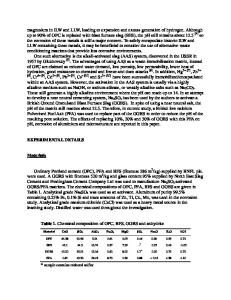Diffusion of Cesium in Sodium Borosilicate Glasses for Nuclear Waste Immobilisation
- PDF / 300,206 Bytes
- 6 Pages / 420.48 x 639 pts Page_size
- 38 Downloads / 363 Views
DIFFUSION OF CESIUM IN SODIUM BOROSILICATE GLASSES FOR NUCLEAR WASTE IMMOBILISATION E.G.F. Sengersi, FJ.J.G. Janssenl and H. de Waal
2
IN.V. KEMA, R&D division, Chemical Research Department, P.O. Box 9035, 6800 ET Arnhem, The Netherlands. 2TNO Institute of Applied Physics - Glass Technology Department, P.O. Box 513, 5600 MB Eindhoven, TheNetherlands.
Abstract Diffusion of cesium in borosilicate glass for high-level radioactive waste is discussed. For this purpose model glasses with non-radioactive elements are being made, in accordance with the specifications of the reprocessing plants, from which concentration couples are composed. A concentration couple consists of two cylinders of borosilicate glass which contain different amounts of cesium. After heat treatment the couples are studied by means of scanning electron microscopy and X-Ray microanalysis. The model study will provide a basis for predictions of the containment achieved over a longer period of time.
Introduction The effectiveness of borosilicate glass in retaining radiotoxic elements such as caesium and strontium during the period of storage is of great importance. Diffusion of alkali ions in nuclear waste glass is of importance, since these ions can migrate through the glass due to a temperature gradient, present in cylinders containing radioactive waste [11. The temperature gradient is caused by radioactive decay of the vitrified fission products. Reliable diffusion data may lead to a better understanding of leaching of alkali ions. Another aspect is that diffusion of ions may contribute to crystallisation, causing mechanical stress or preferential leaching of fission products enriched in more soluble crystals [21. The radionuclides are then released into the biosphere. Ionic flow is caused by a thermal gradient 8T/Sx occurring in cylinders of waste glass, as well as by a concentration gradient 8C/8x. The ionic flux due to these effects is given by Fick's first law: J = -Dt8C/8x + Q*CJRT2(8T1/x)l
(1)
in which D is the diffusion coefficient, C is the concentration, R is the gas constant and Q* the heat of transport. Thus, one value for D pertains to flow due to both gradients 8C/8Ix and 8T/8x [3]. Using an estimate of Q* one can indeed derive the flow by a given 8C/8x from the flow arising from a given 8T/Sx, and vice versa. The latter case is relevant, as for the estimate Q* - 5 kJ/mol [4] the flow driven by 8C/Sx will be larger by an order of four than that due to the temperature gradient 8T/8x. A practical approach to study slow diffusion caused by a thermal gradient therefore consists of the equivalent study of fast diffusion in a concentration gradient. Diffusion coefficients of ions in glass caused by the action of a concentration gradient, may be determined by a number of different methods. Probably the most widely used method is that in which tracers have been used [5-91. Generally, glasses are exposed to salts or gases containing the radioactive tracer ions of the migrating species. The diffusion coefficient obtained by experiments usin
Data Loading...











